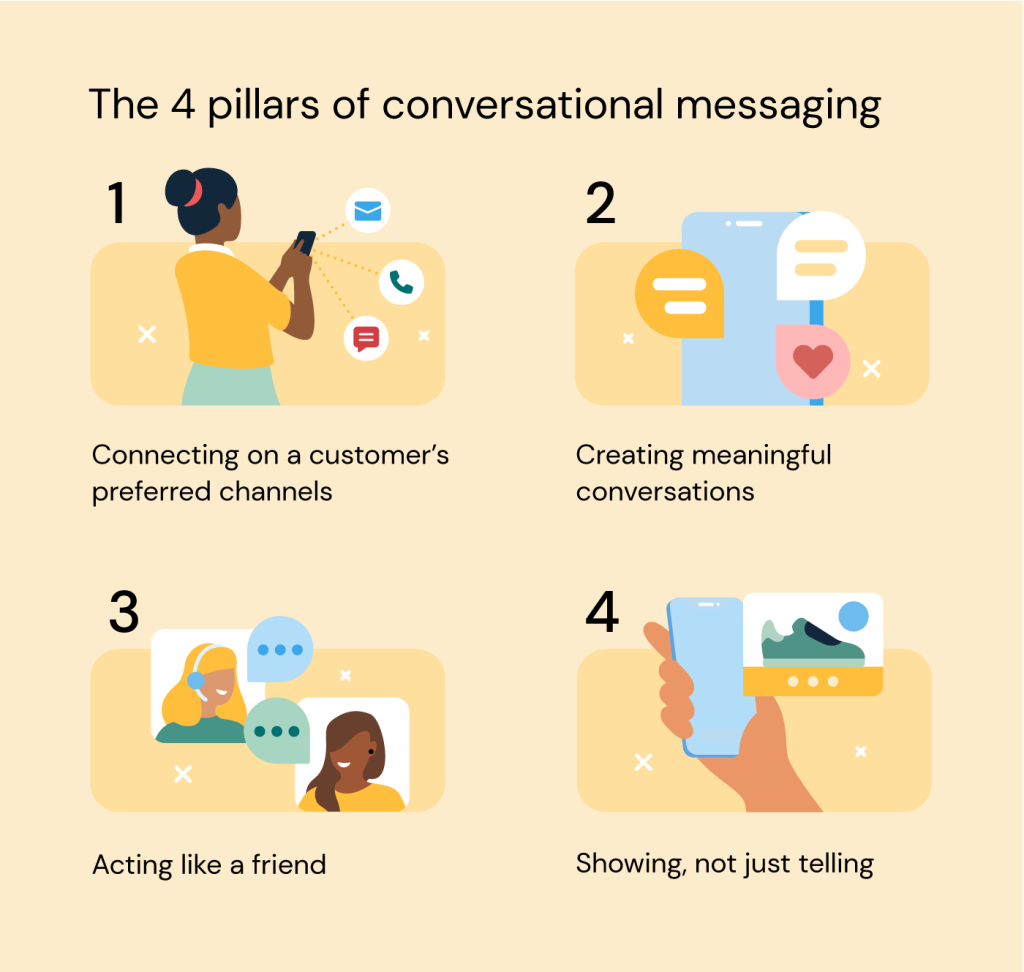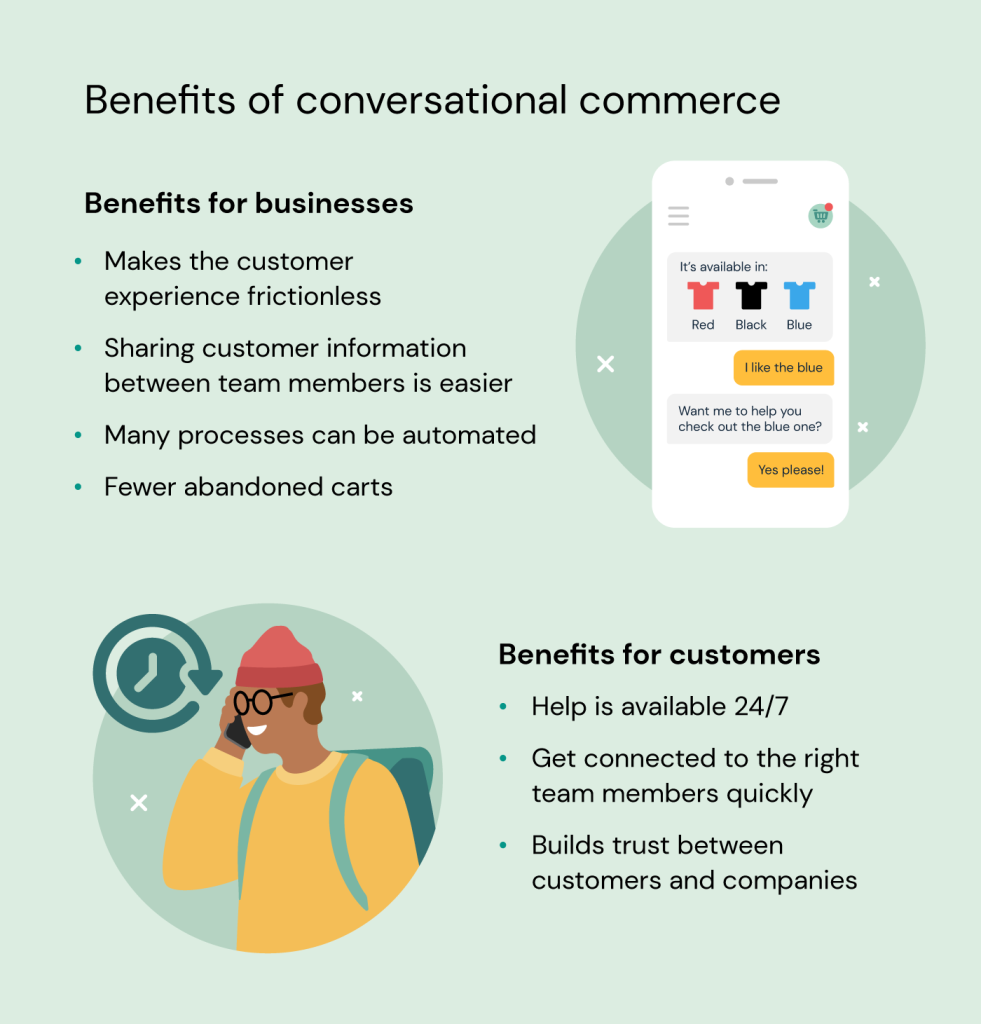Insights
What is conversational commerce? The 2025 guide to smarter customer engagement

Insights

Have you ever been shopping online and had a question about a product? What did you do if you couldn’t find the answer right away? If you’re like most shoppers, you probably left the site and looked elsewhere.
So, here’s the real question: Can brands do more to keep prospective customers engaged and moving toward purchase?
Conversational commerce, powered by AI, is the next big trend in ecommerce. It promises a more personalized, streamlined, engaging, and informative online shopping experience that helps brands build trust and drive conversions.
And here’s why it matters:
In other words, the brands that win in the coming years will do so by providing their customers with the ability to have two-way conversations when they want them the most.
In this article, we’ll explore what conversational commerce is, how to get started, and how it helps you build stronger customer relationships, improve conversions, and future-proof your communication strategy. You’ll see why this matters based on key findings from our 2024 Customer Connections research.
At its core, conversational commerce uses technology to enable personalized, relevant communications between a business and its customers at scale. The most advanced conversational technology uses interactive AI to power conversations across messaging apps, websites, and chatbots. These tools help solve problems, recommend products and answer questions to guide customers toward confident decisions.
When you use these tools to facilitate two-way conversations with shoppers when they’re in the moment of decision or have a critical question, you’ll serve them better and close more sales.
Businesses can use conversational commerce to help customers by:
For businesses to do all of this, they need a combination of live support, AI-powered chatbots, and voice assistants, while using the preferred social messaging channels of your customers. The Sinch Conversation API makes this seamless, so your customers can move across touchpoints without losing context.
In short, conversational commerce brings back the human touch that’s long been missing from e-commerce.

Conversational commerce connects your communication channels – like email, SMS, messaging apps, and web – into one real-time, AI-powered flow.
When customers engage with you through any channel – including email and SMS marketing – your conversational technology can respond and begin interacting with them.
Let’s say an e-commerce customer gets an email or text message promoting a particular product. They’re interested and want to know more, but aren’t ready to buy. So, they click the link and land on your website’s product page or a dedicated landing page.
What happens next?
In a normal online shopping experience, the customer has to search the page or site for more information, and perhaps goes to other sites to get additional questions answered, find reviews, or compare to other products.
With an effective conversational commerce strategy, that same customer can get immediate help. A chatbot can start a friendly, helpful conversation, offering:
All of this can happen within the same messaging app or window – with no extra searching, switching tabs, or waiting on hold.
And it does all this while protecting the customer’s data. In fact, 29% of consumers in our Customer Connections report ranked data protection as their most important concern when becoming a new customer.
Now that we’ve talked about a few of the benefits of two-way conversations with your customers, let’s look at the main types of conversational commerce tools that make it all possible.
AI chatbots enable you to give real-time, semi-automated responses to customers 24/7/365 on your website or any number of messaging platforms. Instead of simply directing customers to contact a live agent during normal business hours, you can tailor chatbots to address nearly any question.
This is similar to how voice assistants, like Siri and Alexa, respond to queries – but more personalized, brand-specific, and integrated with your systems. And if a chatbot runs into a problem it can’t solve, it can pass the customer to live support.
In our research, customers said that the following three things made a chatbot experience positive:
With natural language processing, AI chatbots can deliver helpful, human-like support – even without live customer service or sales agents.
For complex or high-stakes issues, nothing beats a real person. Live agents can step in when a chatbot hits its limit, making the customer experience more personal and seamless.
By combining chatbots and human support, your team can scale efficiently, without burning out your agents.
Voice assistants can guide customers to products and answers just like a chatbot using AI or with a live agent on chat. It’s another type of bot you can offer to customers to meet their communication preferences.
Depending on a customer’s age, where they live, and their place within the sales funnel, they may prefer to communicate by phone or through the voice feature of a messaging app.
Messaging channels like WhatsApp and Facebook Messenger are now essential tools for ecommerce brands. In some markets, super apps like KakaoTalk, LINE, and WeChat combine messaging, payments, and shopping all in one place.
And today’s messaging experiences are going way beyond text, with businesses using RCS messaging to bring app-like capabilities to the native messaging inbox. With RCS, brands can create rich, interactive experiences directly inside a customer’s default SMS app, no downloads required.
That means:
Sinch makes it easy to scale RCS messaging so you can deliver rich, visual messages across both Android and Apple devices.
Being present and responsive on messaging channels is more important than ever. It’s how your customers already live – and expect to interact with you.
So how can conversational commerce technology help your company? Let’s take a look at what it makes possible in a variety of industries.
We’ve mostly talked about online shopping, but did you know that you can use a conversational commerce strategy for in-store shopping as well?
Intermarché, a grocery chain in France, wanted to increase customer engagement and make the shopping experience more fun. They created an AI chatbot that used conversational messaging to suggest new recipes customers could make based on their individual preferences and tastes.
This way, while in the store, the conversational shopping assistant could ask them what they’re in the mood for, suggest a recipe, and then list the ingredients that the customer could shop for, all while they’re in the store.
Financial technology is beginning to embrace personalized customer experiences through conversational technology.
Customers can discuss investment options with an artificial intelligence chatbot before speaking to a human advisor. This allows them to learn about things like their risk tolerance, diversification options, and what it might take to reach their financial goals. The result is more productive meetings once human agents become involved.
A similar approach is now used with insurance, where customers can engage with the conversational artificial intelligence to learn about their risk attributes, insurance options that fit their situation, and how their personal policy may work.
Brazilian food delivery service, iFood, was overwhelmed with customer support inquiries, and response delays hurt revenue because too many potential customers were quitting the process. They used conversational technology with a WhatsApp solution to cut delivery costs and boost driver satisfaction to 91%.
Their chatbot now handles half of all customer service queries – freeing up agents and speeding up onboarding for new partners.
In-person travel agents are mostly a thing of the past. But the problem is, people still need the services they provide. While some real-life agents still exist and there’s a demand for them, conversational AI is finally enabling technology to deliver customer satisfaction that rivals what human agents do in person.
AI chatbots can help people determine itineraries based on their personal interests, purpose for traveling, who and how many people are traveling with them, and the places they like to stay and eat while traveling.
Beyond help with planning, these assistants can share reviews, suggest dining and hotel options, and offer personalized travel tips – all in one conversation.
In fact, conversational commerce can even help with visa eligibility, which can be difficult to navigate in certain countries.
Fantacalcio is an online fantasy football service in Italy with more than five million users. As you can imagine, their customer interactions skyrocket during the sports season but dissipate during other times of year.
It’s not practical to have a large customer service team that they have to lay off and rehire every year, or pay for months during the offseason with far less activity. They offer a complex service with all sorts of customizations, which generates a lot of support tickets, with 15-20% of their user base seeking help on a regular basis.
Before automation, customers often experienced long wait times and repetitive back-and-forth with support teams – especially during seasonal spikes.
But with an AI chatbot now handling 3,000 customer service inquiries per day across WhatsApp and Facebook Messenger, it takes on the initial interactions for all users, sends links to tutorials, and only involves live agents when necessary. Reply time has been cut in half, and the whole enterprise is operating on a much higher level.
“Thanks to the bot, we were able to reduce reply time by 50%. All chats that require human assistance are now resolved within an hour maximum.”
The landscape is changing fast as the possibilities of AI expand. People want real-time, two-way interactions across multiple channels and at all different points of their customer journeys, powered by technology that’s fast, relevant, and secure.
Based on real conversations with industry leaders, the Sinch team’s first-hand experience, and data from our Customer Connections survey, here’s what’s shaping the future of conversational commerce.
As technology improves across the board, it’s becoming easier and more affordable for businesses of all sizes to connect with customers across multiple channels.
Whether shoppers engage via messaging apps, MMS, email, your website, or other methods, your systems can now support seamless movement between these touchpoints, and reply back with relevant information. Conversations can continue without starting from scratch.
Take this stat from our Customer Connections survey: 32% of newly acquired ecommerce customers say order tracking is their top priority. With omnichannel integration, a customer can interact with your company through WhatsApp, order through your website, and receive order tracking details through text or push notifications.
The more customers experience the power of conversational commerce, the more they’ll expect it – especially from larger brands with the scale and resources to deliver it.
According to our Customer Connections report:
of consumers expect to hear from brands within 24 hrs of signing up
of consumers expect a receipt within five minutes
of consumers prefer customer service through messaging channels
of consumers prefer email for messaging channels
Email still has its place, but it can be too slow for customer support. Consumers want answers now, and with conversational AI working through chat apps and messaging channels, you can provide those answers. At scale, this can improve conversion rates and customer retention.
Since the rise of ChatGPT, consumer openness to AI tools has jumped.
The takeaway? In 2025, AI is growing in acceptance, but human support isn’t going away anytime soon. The goal is not to replace people – it’s to make every interaction more efficient, consistent, and useful.
Today, 30% of companies already use AI in customer communications. As trust increases, so will innovation.
While conversational commerce opens doors to better engagement, it’s not without risks. A fair number of consumers, 17%, cite data privacy concerns as a major deal breaker and 26% say that receiving too many messages discourages purchases. Personalization, smart frequency capping, and transparency around data usage are critical to maintaining trust.
of consumers say data privacy is a major concern
of consumers say receiving too many messages discourages them from buying
The first step? Think like your customers.
Once you’ve mapped the key moments, you can start to automate the right interactions. Here are a few starting points:
Conversational commerce looks different for each business. Ask yourself these questions:
When you have these answers, you can start deciding what you need to prioritize. There isn’t a single way to create better conversations with your customers, but by focusing on the communication channels that will be most effective for your customer base, you’ll be off to a great start.
Look at where your customer interactions break down.
These pain points are where conversational tools can have the biggest impact. Train your team on how and when AI should step in – and how to transition to human agents when needed.
You don’t need to launch a comprehensive conversational strategy all at once. Start with quick wins:
Focus on helping – not just responding.
With today’s APIs, you can analyze the data of every conversation as it’s happening. Collecting and comparing metrics will help you further refine the way you implement conversational commerce. The more thoroughly you measure and evaluate what you’ve learned, the more natural and helpful conversations you’ll have with your customers.
Here are some frequently asked questions from businesses looking to get started with conversational commerce.
Using a conversational marketing strategy has numerous benefits for both customers and teams. Key benefits include:

Conversational commerce is about having two-way conversations with customers across multiple channels using AI-powered chatbots supported by human agents.
Social commerce focuses on selling directly through social media platforms, enabling shoppers to browse and buy without leaving apps like Instagram or TikTok.
AI is what makes true personalized experiences possible at scale.
Unlike older chatbots that relied on static rules, modern conversational AI uses customer data to:
That means faster support, smarter recommendations, and better conversations.
Want to find out more about how a conversational commerce platform might help your company? Sinch has long been leading the way for companies that want to effectively create, manage, and grow a conversational commerce ecosystem that leverages generative AI for large companies.
Sinch, the Customer Communications Cloud, directly powers meaningful conversations on your customers’ favorite channels at every stage of their journey.
With offerings that bring communication channels together to form omnichannel systems that center the customer, Sinch is ready to guide and support your journey.
Curious how conversational commerce could work for you? Let’s start the conversation.